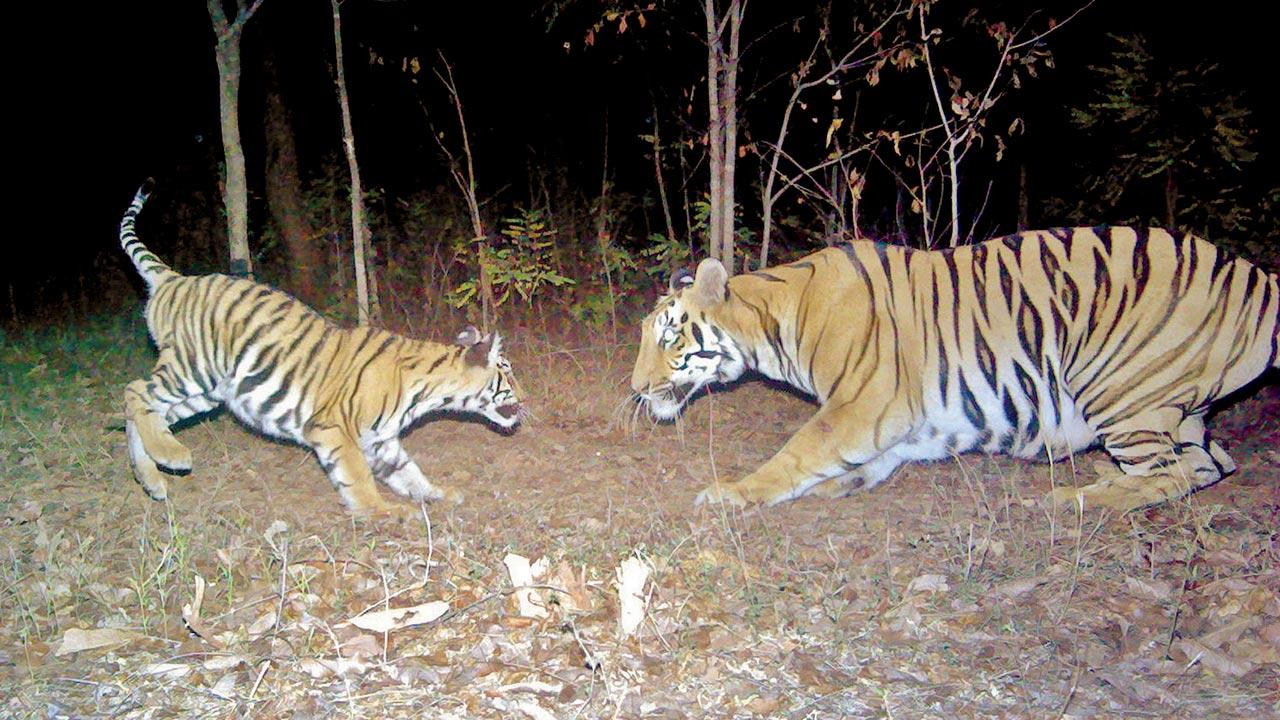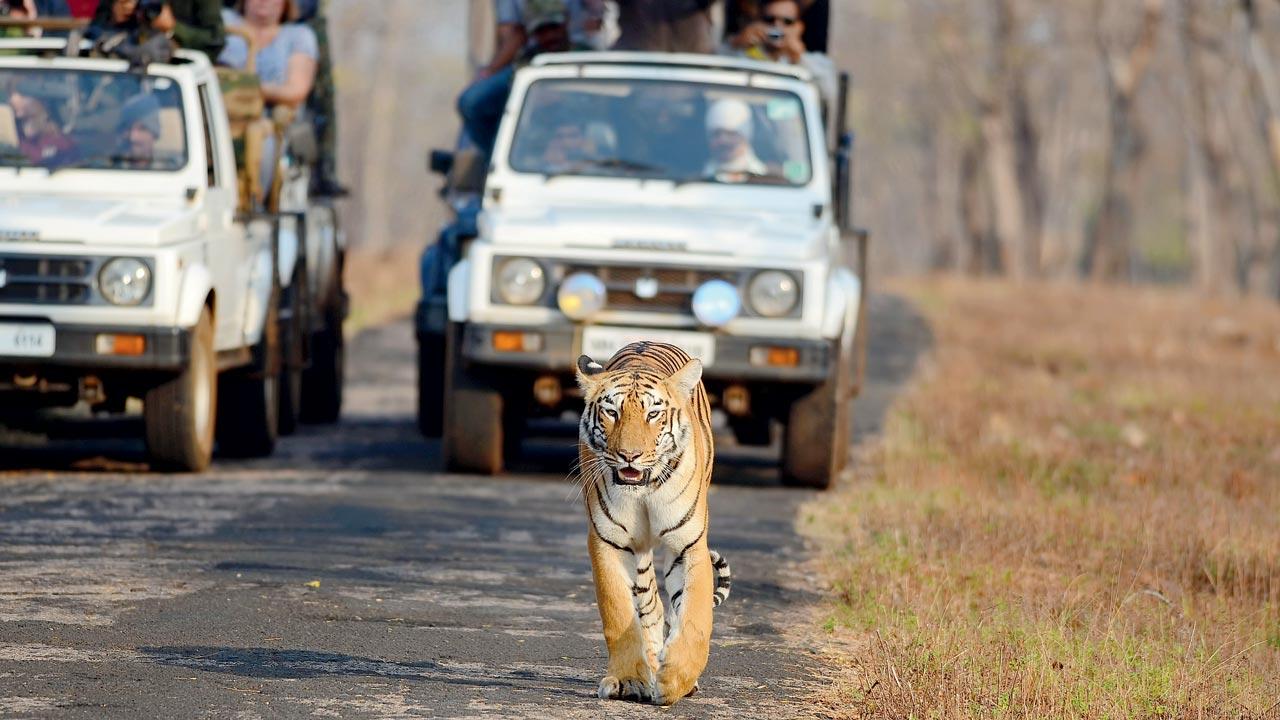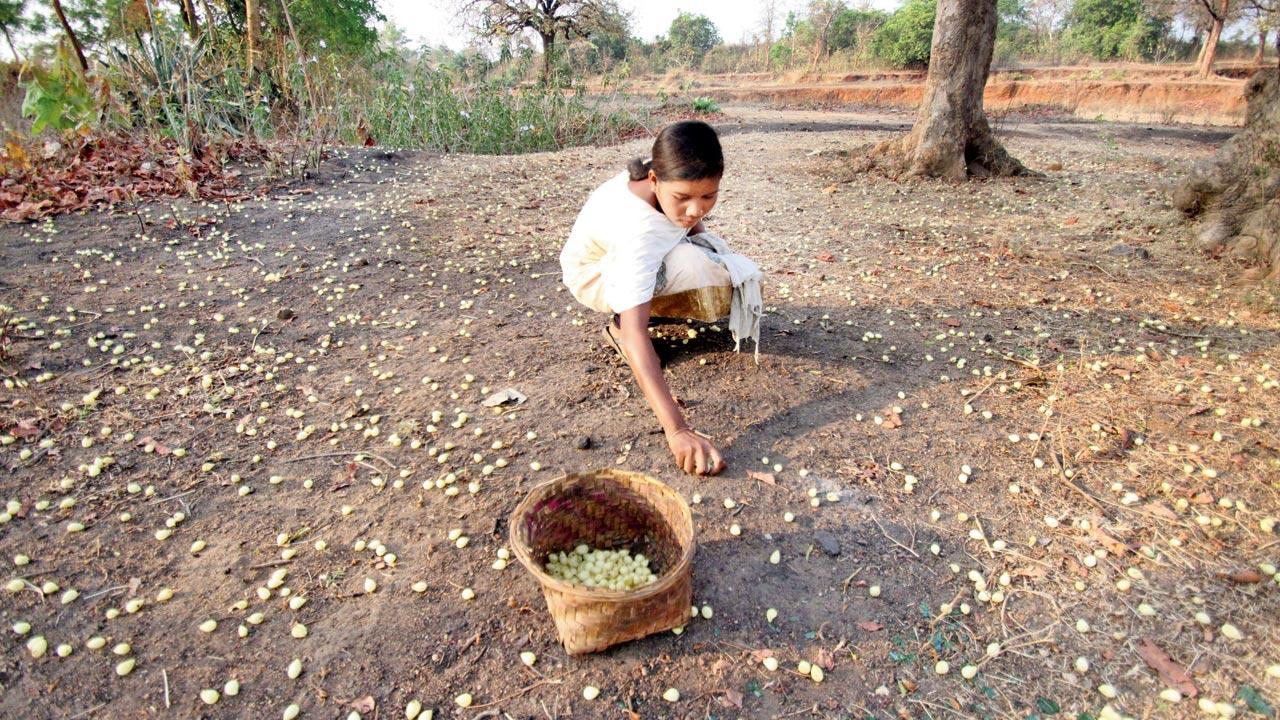We know we might sound like killjoys. But before you raise a toast to the India Tiger Census figures, listen in to why state’s wildlife conservation champions are a worried lot

Pic/Istock
Picture a post-apocalyptic world, with the inhabitants running out of resources. As a result, they turn on each other, and anyone else crossing their path. Fights break out over food, leading to violence and death. As groups start migrating from their depleted neighbourhoods, territorial clashes erupt—it is survival of the fittest.
ADVERTISEMENT
Now, apply this scenario to tigers.
 A tiger and its cub captured on a camera trap in a forest in Chandrapur district. Camera traps are installed in forests and tiger reserves to track the movements of the big cats and also help with the census every four years. In the 2022 census, a total of 3,080 tigers were captured in 32,588 camera traps all over India. Pic Courtesy/Anish Andheria
A tiger and its cub captured on a camera trap in a forest in Chandrapur district. Camera traps are installed in forests and tiger reserves to track the movements of the big cats and also help with the census every four years. In the 2022 census, a total of 3,080 tigers were captured in 32,588 camera traps all over India. Pic Courtesy/Anish Andheria
According to the fifth cycle of the All India Tiger Estimation (2022) released last week, the number of tigers in India has risen by 200 in the last four years—from 2,967 in 2018 to 3,167 in 2022. In contrast, the data revealed, the Western Ghats which include our state of Maharashtra plus neighbouring Goa, Kerala and Tamil Nadu, and are said to hold the world’s single-largest tiger population, recorded a significant decline. The numbers here fell from 981 tigers in 2018 to 824 unique tigers.
The good news? Maharashtra specifically saw a decent rise in tiger population, from 312 in 2018 to 375 in 2022.
While on one hand the positive numbers are being hailed as the success of Project Tiger, launched in 1973 to ensure a viable big cat population in India, experts and activists are a worried lot. They are concerned that this could signal an even higher number of Human-Wildlife Conflict (HWC) cases. Their reasons are simple—tigers today are running out of forest cover, prey availability and water, and are venturing into human-populated areas for survival.
 A tigress stalks through the Tadoba-Andhari Tiger Reserve, as tourists follow. Pic/Getty Images
A tigress stalks through the Tadoba-Andhari Tiger Reserve, as tourists follow. Pic/Getty Images
A Right To Information query filed by mid-day’s senior journalist Ranjeet Jadhav in February had revealed that in the last 10 years, there have been 624 human fatalities and over 5,000 casualties due to HWC. Authorities say that over 50 per cent of these cases involve either tigers or leopards.
The third largest state in India, Maharashtra has a total recorded forest area of 61,952 square kilometres, which includes 50,865 sq km of Reserved Forest, 6,433 sq km of Protected Forest and 4,654 sq km of Unclassed Forests, the latter comprising all forests other than Reserved Forests and Protected Forests. The Gugamal National Park in Melghat, Tadoba in Chandrapur and Pench in Nagpur on the border of Maharashtra and Madhya Pradesh, are among the main tourist attractions for
wildlife enthusiasts.
 Villagers burn the undergrowth in forests twice a year so that the ground remains dark, making it easier to spot mohua flowers, which are collected and sold, or used for processing liquor. More often than not, the fire spreads to other areas, damaging the tigers’ natural habitat and giving rise to human wildlife conflict. Pic/Getty Images
Villagers burn the undergrowth in forests twice a year so that the ground remains dark, making it easier to spot mohua flowers, which are collected and sold, or used for processing liquor. More often than not, the fire spreads to other areas, damaging the tigers’ natural habitat and giving rise to human wildlife conflict. Pic/Getty Images
“While we celebrate the higher numbers—and this is important as the people on the ground working for wildlife conservation deserve a pat on the back—we should also be equally concerned that many potential tiger habitats are constantly under-performing in terms of providing for the big cats. We have finished 50 years of Project Tiger, but what is our strategy for the next 50 years?” asks Kedar Gore, wildlife conservationist and director of the Corbett Foundation.
According to Gore, India has declared 53 tiger reserves spread over 75,000 sq km in 20 states occupying around 2.5 per cent of India’s geographical area. “Tiger reserves are divided into core and buffer zones. The core zones are considered as ‘critical tiger habitat’ and, as per the Wild Life (Protection) Act, must be kept inviolate for the purpose of tiger conservation. Buffer zones should have habitat connectivity with the core so that the spillover population of tigers can establish themselves in the buffer or use the buffer to move into other forest areas through forest corridors,” he says. As part of Project Tiger, making a sanctum sanctorum for tigers in tiger reserves, Gore says, was one of the most challenging tasks for the government. “The villages in core zones had to be voluntarily relocated to create inviolate spaces for tigers. It has taken a great deal of efforts by the government and the sacrifice of local communities by giving away their homes to provide a safe home for India’s tigers, even if they were compensated for it.” Out of the 750-odd villages that were present in the core zones, so far around 180 villages with more than 14,500 families have been voluntarily rehabilitated to create critical tiger habitats of around 34,000 sq km across all tiger reserves in India. “Between 2014-15 and 2020-21, around R578 crore has been spent for this work. Still, around 570 villages are inside the core of our tiger reserves.”
 Anish Andheria, Kedar Gore and Bandu Dhotre
Anish Andheria, Kedar Gore and Bandu Dhotre
So, when the tiger population sees an uptick in an already crunched reserve, it could spell trouble. In Maharashtra, the increasing number of tigers in locations like the Tadoba-Andhari Tiger Reserve in Chandrapur of Vidarbha, has resulted in the reserves being unable to hold the tigers, leading the animals to move to connecting corridors. The Chandrapur district has the largest tiger population in the state, with around 200 tigers believed to be focused in reserves like Tadoba. Experts point out that more often than not, they migrate to areas near human settlements to prey on cattle. “Most people who end up in conflict with the tigers are legitimate residents of the villages for decades. They depend on the nearby forest for livelihood and daily needs,” Gore argues.
The survival of tigers in any habitat depends on them getting their needs fulfilled within that space. When tiger habitats are formed, meadows are created and developed for years together so that grasslands can be created for herbivorous animals to feed on, who in turn become the available prey for tigers. However, the creation of these habitats needs to be well planned, in the sense that if all the prey animals feed at the same spot, a major chunk of the tigers will converge there, creating an imbalance. A tiger, experts say, breeds well in the presence of plenty of food and water, and adequate forest cover. But too many tigers breeding in one reserve are bound to cause infighting over females and territory, pushing them to migrate and bringing them in direct contact with humans.
Anish Andheria, Chief Executive Officer of the Wildlife Conservation Trust, says that in the Brahmapuri forest division of Chandrapur, around 40 to 50 humans have been killed every year on an average for the last five years. The area witnessed 50 deaths in 2021 and around 45 in 2022. The WCT has been conducting research in the Chandrapur district in collaboration with the Maharashtra government, and tries to provide solutions to boost wildlife conservation as well as to minimise HWC.
“More than the population of tigers, it is the degradation of forests that has a direct connection to HWC. There are certain corridors [forested areas intermixed with grasslands and wetlands, providing connectivity between protected areas] in the same landscape as Brahmapuri where the density of tigers is more, and yet the incidence of HWC is lower. Because the forest cover is adequate. In Chandrapur, attacks usually occur when locals enter the forest to collect mohua flowers and tendu leaves,” Andheria says. Tendu leaves or tendupatta are in high demand since they are used to roll beedis, the recreation of choice for lower income groups across India. The mohua flower, scientifically known as Machuca Longifolia, is used by locals for a wide variety of purposes, from medicinal and nutritional to sweetening and preparation of liquor. The bright yellow flowers bloom during the months of March and April and are collected only after they fall. “In order to make them easier to spot, the villagers burn the undergrowth twice a year to keep the forest floor dark. More often than not, this fire spreads to the tiger reserves or corridors. Sometimes, locals also send their cattle to graze here. The depletion of forests leads to a negative interaction between man and beast.”
The basic and crucial criterion for tigers to thrive is that the carrying capacity of the tiger bearing area be maintained. This can only be done if the forest is well protected. With not enough defence against external elements (poachers, villagers), the prey and water starts dwindling, forcing the tigers out of their habitats. “Whenever forests are degraded, they should be restored immediately. One of the first things to happen, when a forest starts degrading is the infestation of lantana weeds [they can also climb over trees and creepers]. Today, almost 40 per cent of India’s tiger-bearing forests are infested with lantana weeds, and the cost of uprooting them is huge. Weed infestation reduces the palatable vegetation for herbivores, which are prey for carnivores,” says Gore, explaining that this is how the entire food chain is disrupted.
Over the years, due to the frequent loss of life or serious injury caused by HWC, the outlook of local residents towards the tigers has also changed, and not for the better. In 2008, a coal mine was announced near Tadoba, which was met with stiff opposition from villagers and activists alike, who refused to let the rich wildlife in their district be affected by commercial interests. After two hunger strikes, the project was finally called off. Cut to 2023, when the same villagers who poured out on the streets for tigers and their habitats are now picking up arms against them to exact revenge for their fallen comrades.
In 2012, when the Tadoba Andhari reserve was declared a buffer zone, the authorities created water bodies all across the area. Soon, grass started growing and animals like sambar and barking deer started grazing at these spots, and the tigers followed. The tiger population in Tadoba, which was at 40 before 2012, now stands at 90. “[But] the resources are not proportionate with the tiger population, be it in Tadoba or Brahmapuri,” says Bandu Dhotre, who was among the people who sat on a hunger strike in 2008, and is now fighting desperately to save the lives of fellow villagers in Chandrapur under the aegis of his NGO, Eco Pro. “A tigress, unable to find enough prey for herself and her cubs, moves to the villages to hunt cattle. A cow or a buffalo gives enough meat for the entire family. A direct consequence of this is that the young cubs grow up learning that cattle are easier to hunt, and only will look out for domestic cattle to attack after that.”
He cites another trend that is giving rise to an imbalance between the big cats and their habitat. “In 2018, a tigress settled at a nullah near the Chandrapur Super Thermal Power Station. Her cub, who had never entered a forest, made its way to the Satpura power station in Madhya Pradesh, where it was captured after causing panic among the employees,” Dhotre says.
Where then, is the solution for the rapidly increasing disparity between India’s national animal and what its land has to offer to the majestic beast? There does not seem to be a quick fix for this. Experts say that a lot of damage has already been done. “Every time there is a human death, entire villages go into lockdown, to the extent that locals plan what to eat at night, so that they don’t have to attend nature’s call before sunrise the next morning,” says Dhotre.
The increase in tiger population then, is not good news for them. Gore recommends that people’s feelings be assuaged immediately with prompt action. “Every time there is an attack, compensation to the victims or their families should be made available immediately. The longer you delay it, the more scope you are creating for retaliatory feelings. It is useless to expect people to stop going into forests. Local communities prefer firewood over cooking gas, and no matter how many toilets the government builds, many will still prefer the woods. If the government’s response to HWC instances is not quick, the people will look for revenge, worsening the conflict even further,” says Gore.
Andheria has a host of other ideas, aimed at making the villagers less dependent on the forest to begin with. His suggestions stem from a project that the WCT conducted in 2012 in the Brahmapuri region, where water heaters were provided to the villagers at a lower cost. The heaters worked on one-third of the quantity of firewood required in a normal wood-fuelled stove, and could also make use of crop residue and dung, greatly reducing the number of trips the villagers had to make to the forest for wood.
“We can look at reducing the number of livestock in villages close to tiger reserves or corridors. Currently, the villagers are raising dung cattle, but those don’t produce milk. If these are replaced with milch cows, they will be able to earn more by selling dairy products... it will bring down the number of cattle they currently raise to one-fifth. There can also be other skill development programmes that can reduce the dependence of villagers on agriculture and help them earn through non-forest related work,” Andheria suggests.
It’s clear, then, that we must preserve what we have while it’s still available to us. As Dhotre puts it, “It’s hardly as if we can create new habitats and point tigers towards them, and they’ll happily turn around and go there.”
5:5
In October 2022, human-tiger interface in Chandrapur district reached flashpoint when a human was reported killed in a big cat attack daily over five consecutive days leading to discussion around the need for active population management
95
No. of deaths the Brahmapuri forest division in Chandrapur of Maharashtra alone witnessed between 2021 and 2022 to man-animal conflict
State’s forest cover
The biennial India State of Forest Report-2021 (ISFR) revealed that while Maharashtra’s forest cover increased by 30 sq km, it has depleted in forested districts of Chandrapur and Gadchiroli, which are home to a majority of tigers. The ISFR is arrived at by using wall-to-wall mapping of India’s forest cover with the help of remote sensing techniques and sample plot-based national forest inventory.
Forest cover lost
Gadchiroli 14.12 sq km
Chandrapur 4.19 sq km
Nagpur 1.59 sq km
 Subscribe today by clicking the link and stay updated with the latest news!" Click here!
Subscribe today by clicking the link and stay updated with the latest news!" Click here!







